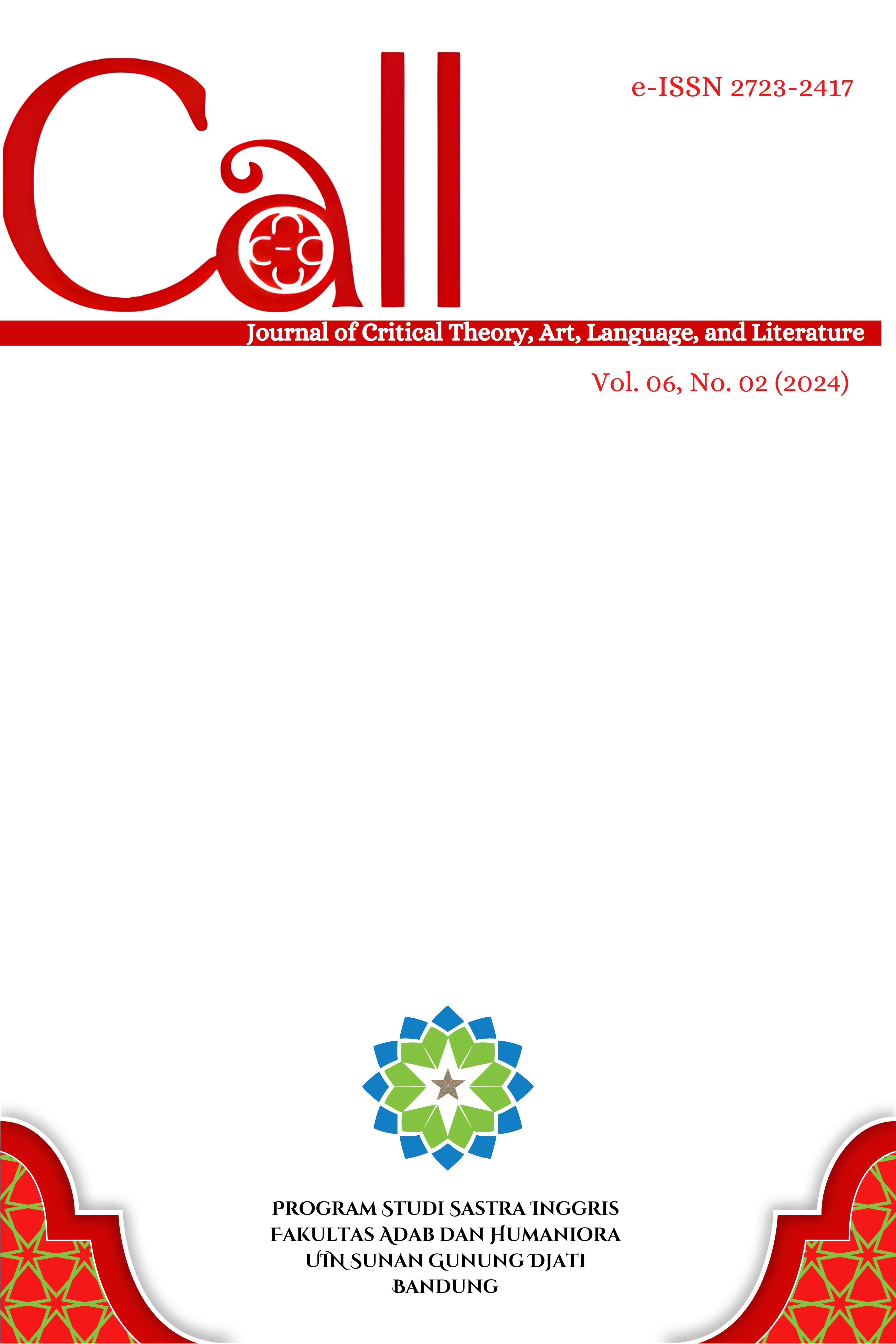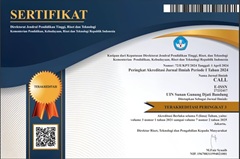THE USE OF CODE SWITCHING IN YOU AND INSECURITIES (2023) NOVEL BY AYYA
DOI:
https://doi.org/10.15575/call.v6i2.38195Abstract
This study aimed to identify the codes used, the types, and the reasons of the use of code switching found in the conversational expression in You and Insecurities novel by Ayya. The researcher analyzed the types of code switching using the theory proposed by Poplack (1980) and the reasons of code switching based on the Hoffmann's (1991) theory. The findings showed that the characters employed three languages in the conversations, those are Indonesian, English, and Sundanese. The most frequent types of code switching found is inter-sentential switching. It can be seen that the characters in the novel have good English skill because they have the ability to intentionally switch the language from Indonesian to English and vice versa. The most frequent reasons of code switching found is talking about particular topic. The characters employed code switching in their conversation to talk or discuss a certain topic because they feel free and comfortable to express their feelings and to make the communication easy to understand. By analyzing the codes, the types, and the reasons of code switching found in You and Insecurities novel using sociolinguistics theories, the researcher realized that a sociolinguistics approach can reveal how language in a novel reflects different social groups, the dialects and languages used by the characters, and how the social and cultural context influences the narrative. The communication style of urban people of Jakarta, in particular of the young executive group identity, is reflected in the studied novel that is You and Insecurities by Ayya. Keyword: bilingualism, multilingualism, code switching, novel
References
Adi, W. T. (2018). Code Switching in Critical Eleven Novel. Metathesis: Journal of English Language, Literature, and Teaching, 2(1), 39.
Ambanilah, E., Hidayat, A., & Rosalinah, Y. (2021). Applied, type and rational-using of code switching in Insecurity novel. LADU: Journal of Languages and Education, 1(3), 123–131.
Anggraeni, D. (2021). Types of Code Switching Used in The Naked Traveler Novel. Scope : Journal of English Language Teaching, 5(2), 63.
Bhatia, T. K. Ritchie, W. C. (2013). The Handbook of Bilingualism and Multilingualism (2nd ed.). Oxford: Wiley-Blackwell
Bogdan, R. C., & Biklen, S. K. (1982). Qualitative Research for Education: An Introduction to Theory and Methods Fifth Edition. USA: Pearson Education, Inc
Creswell, J. W., & Creswell, J. D. (2018). Mixed Methods Procedures In Research Design: Qualitative, Quantitative, and Mixed Methods Approaches. USA: SAGE Publication, Inc
Febryanti, N. K., Hadi, M. Z. P., & Hastuti, H. (2019). An Analysis of Code-switching Used in ‘The Architecture of Love’ Novel Written by Ika Natassa. Humanitatis: Journal on Language and Literature, 6(1), 109–118.
Gusti Agung Sri Rwa Jayantini, I., & Made Verayanti Utami, N. (2021). Code Switching and Code Mixing in Negeri Para Bedebah Novel. Social Science, Public Administration and Management (HUSOCPUMENT), 1(2), 60–69.
Hoffmann, C. (1991). An Introduction to Bilingualism. New York: Longman Linguistics Library
Holmes, J., & Wilson, N. (2022). An Introduction to Sociolinguistics, Sixth Edition. London: Routledge.
Larasani, G. P., & Sadia, I. G. (2019). The Analysis of Code Switching in the Novel “Critical Eleven†by Ika Natasha. Humanis, 23(2), 101.
Mirani, R., Pratama, D., & Hastuti, D. P. (2020). Code Mixing and Code Switching in Twivortiare 2 Novel By Ika Natassa. 12(2), 288–295
Poplack, S. (1980). Code Switching: Anthropological and Sociolinguistics Perspectives. New York: Mouton De Gruyter
Sendang Rezeki, L. (2021). Analisis Majas Personifikasi pada Novel Ibuk Karya Iwan Setyawan. Jurnal Berasa (Beranda Sastra), 1(2), 52. https://berasa.ejournal.unri.ac.id/index.php/berasa
Sentana, A. (2022). Code Switching Analysis in the Novel Entitled a Very Yuppy Wedding. 94- 104.
Suhardianto, S., & Afriana, A. (2022). The Types and Factors of Code Switching in “English Time†Course. IdeBahasa, 4(1), 53–62.
Wardhaugh, Ronald. (2006). An Introduction to Sociolinguistics Fifth Edition. Oxford: Blackwell Publishing
Yosi, N. P. D., & Sadia, I. G. (2019). Analysis of Code Switching in Dialogue of Indonesian Novel Permainan Maut by Lexie Xu. Humanis, 23(3), 176.
Downloads
Published
Issue
Section
Citation Check
License
Copyright (c) 2024 CALL

This work is licensed under a Creative Commons Attribution-ShareAlike 4.0 International License.
Authors who publish in CALL agree to the following terms:
- Authors retain copyright and grant the journal right of first publication with the work simultaneously licensed under Attribution-ShareAlike 4.0 International (CC BY-SA 4.0) License that allows others to share the work with an acknowledgment of the work's authorship and initial publication in this journal.
- Authors are able to enter into separate, additional contractual arrangements for the non-exclusive distribution of the journal's published version of the work (e.g., post it to an institutional repository or publish it in a book), with an acknowledgment of its initial publication in this journal.
- Authors are permitted and encouraged to post their work online (e.g., in institutional repositories or on their website) prior to and during the submission process, as it can lead to productive exchanges, as well as earlier and greater citation of published work (See The Effect of Open Access).




